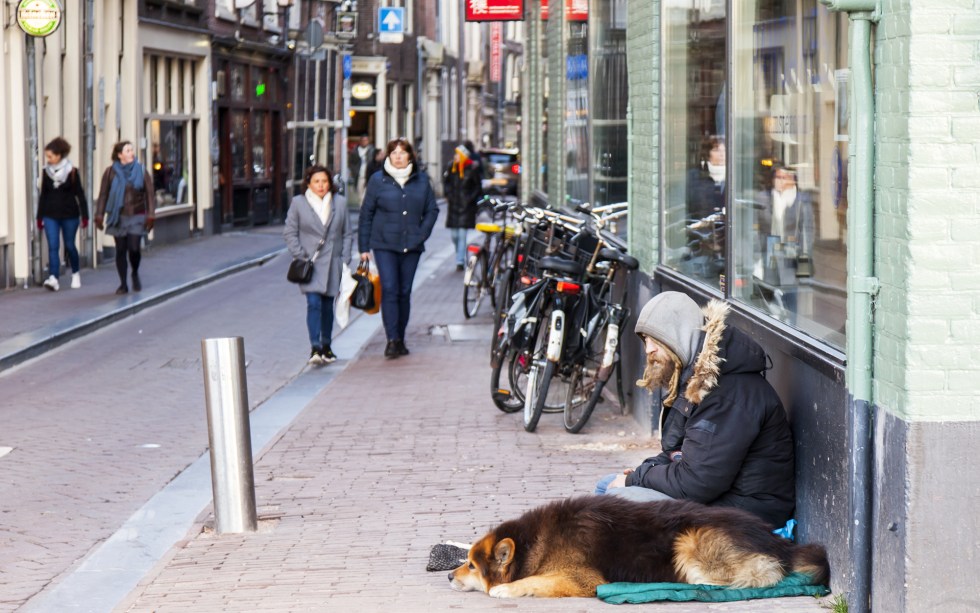Amsterdam has introduced the “Contactless Payment Jackets” for beggars, an electronic payment system that allows people to donate to the homeless.
Amsterdam Fully Embracing Digital Payments
Although the recent demonetization policies are mostly felt in developing countries where the economy is predominantly cash-based, developed countries are actually spearheading the movement. Most recently, the Netherlands have joined the ranks of developed countries like Sweden and Denmark in the war on cash.
As a consequence of a society that relies heavily on banks and electronic payment systems, and as an effort to further this standard, Amsterdam has introduced the Contactless Payment Jacket allowing cashless donations to beggars on the street.
Contactless Payment Jackets
Developed by Carsten van Berkel and Stefan Leendertse of N = 5, an Amsterdam-based advertising agency, the Contactless Payment Jacket allows citizens to donate an automatic sum of 1 Euro simply by holding their contactless smart card close to the jacket worn by beggars, which has a card reader sewn into it.
The money donated is transferred to a bank account managed by a homeless shelter, and can only be used to purchase food, baths, and accommodations at a homeless shelter. Receivers can also choose to save the donation, which can later be used to help beggars and homeless people get back on their feet.
War on Cash Escalating
Much like actual war, the “war on cash” currently spreading throughout the globe can take many forms and rely on different strategies. In Amsterdam, the demonetization efforts have taken a lighter tone than the ones applied in countries like India or Venezuela.
In these countries, the high denomination bills are simply deemed “useless”, forcing citizens to rush to banks to exchange or deposit them. India has even gone as far as to introduce biometric payments that are protected by thumbprint recognition, issuing every Indian citizen with a 12-digit ID called Aadhaar to use in said payments.
The biggest difference between these countries, however, is the time frame in which the demonetization is taking place. India’s Prime Minister Narendra Modi announced the removal of the countries’ largest bills on national television giving only a 72-hour exception for paying for hospital bills and airline tickets, which led to an immediate upheaval in the country.
But even though on the surface Amsterdam’s latest step appears to facilitate charity, the removal of cash actually has the most negative impact on the poor as we’re currently seeing in India.
“…As the money supply deflates, it further produces a reversed Cantillon effects phenomenon: a transfer of wealth from those still waiting in queues to those who have already exchanged their notes, as the diminishing cash stock pushes up the purchasing power of the rupee,” explains economist Carmen Dorobăț.
And while the introduction of the Contactless Payment Jackets makes donating more reliable since the donation can only be used for specific purposes, it undermines the privacy and financial freedom of the recipients who are now limited to these three options.
Moreover, as these cashless measures are taking various shapes and forms, they all lead up to the same result: direct person-to-person transactions will be eliminated, allowing every transaction to be monitored, controlled, and cut off with the flip of a switch, if authorities deem necessary.
Demonetization in Europe
Many countries have adopted demonetization policies within the European Union. Scandinavia is at the forefront of demonetization in the E.U. with the Danish government now allowing retailers the right to refuse cash payments, for example. Norwegian banks are also refusing to work with cash, while in Italy, France and Spain cash transactions have been limited to a thousand Euros.
Cash is Still King
Although this may change in the future, cash is still considered the dominant payment method in many countries. According to a study by Bloomberg, which takes into account the spending habits of more than 18,000 people in seven countries, cash is still king — even in countries like Austria, Canada, France, Germany, the Netherlands, and the U.S.
Despite the advantages offered by credit card companies, online payment systems, and cryptocurrencies, the private and peer-to-peer nature of cash makes it still the most used payment method throughout the world.
This demonstrates that even if demonetization could actually curb corruption and the black market, it may change the lives of many ordinary citizens for the worse both in the developing and developed world. Pakistan and Australia are just a couple of other countries also considering a cap on cash transactions and a ban on high-denomination notes.
Can cash be completely eradicated from the world? Will contactless payments ultimately help or hurt the homeless? Share your thoughts below!
Images courtesy of theguardian, odditycentral, bloomberg
